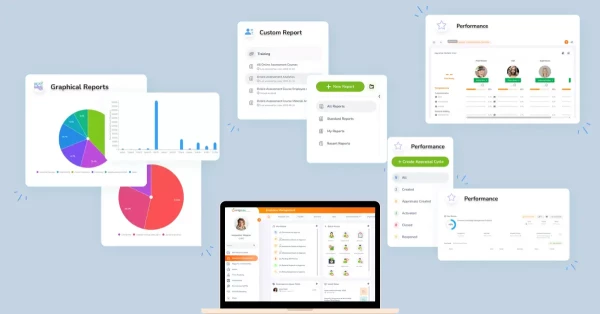The Evolution of HR: From Administrative Back Office to Strategic Command Center
For decades, Human Resources (HR) was largely perceived as an administrative function—handling payroll, managing benefits, and tracking compliance. While crucial, this operational focus often left HR on the periphery of strategic planning. Today, however, the landscape has fundamentally shifted. The most valuable asset in any organization is its people, and the tools used to measure, analyze, and optimize that asset—HR Reporting and HR Analytics—have become indispensable levers for driving Organizational Performance and overall business strategy.
HR Reporting is the process of collecting and summarizing key HR data (e.g., headcount, turnover rate, time-to-hire) to reflect the current state of the workforce. HR Analytics, conversely, is the practice of using statistical methods and modeling to interpret that data, diagnose causes, and predict future trends, enabling Strategic HR decisions.
By leveraging advanced Data-Driven HR insights, HR professionals are now able to quantify the impact of people on the bottom line, moving beyond simple cost centers to becoming true strategic partners who contribute measurably to the company's financial and operational goals. This comprehensive analysis explores the mechanisms, factors, tradeoffs, and challenges involved in using sophisticated reporting and analytics to align the workforce with the overarching business strategy.
Key Factors Impacting the Strategic Use of HR Data
The successful integration of HR data into corporate strategy relies on three foundational pillars: Data Quality, Analytical Maturity, and Strategic Alignment.
1. Data Quality and Integrity
The foundation of any analytical effort is reliable data. Poor data quality—inaccurate, incomplete, or inconsistently formatted data—leads to flawed insights and misguided strategies.
-
Standardization: Ensuring that metrics like "voluntary turnover" or "full-time employee" are defined and tracked uniformly across all departments and geographies.
-
Integration: Consolidating data from disparate systems (HRIS, payroll, performance management, engagement surveys) to create a single source of truth. Without integrated data, cross-functional analysis (e.g., linking training investment to sales performance) is impossible.
2. Analytical Maturity of the HR Function
HR teams must develop data literacy. It's not enough to run reports; HR professionals must be able to interpret statistical correlations, understand data visualization, and, most importantly, translate data into a compelling narrative for the C-suite.
-
Descriptive vs. Prescriptive: Moving up the analytical maturity curve means transitioning from Descriptive Analytics (What happened?) to Diagnostic (Why did it happen?), then to Predictive (What will happen?), and finally to Prescriptive Analytics (What should we do about it?). Strategic impact happens at the predictive and prescriptive levels.
3. Alignment with Business Goals
Strategic HR data is inherently linked to business outcomes. The key performance indicators (KPIs) tracked by HR must directly map to the company's goals (e.g., if the company goal is market expansion, HR KPIs must focus on Talent Acquisition metrics for specific geographies or technical skills).
-
Key Metrics for Strategic Impact: Instead of merely reporting headcount, strategic metrics focus on:
-
Revenue per Employee: A direct measure of workforce efficiency.
-
Regrettable Turnover: Losing high-performers versus low-performers.
-
Time-to-Productivity: How long it takes a new hire to reach peak performance.
-
ROI of HR: Quantifying the return on investment for training, wellness programs, or total rewards.
-
Moving Beyond Reporting: The Power of Predictive Analytics
True strategic contribution comes from using analytics to anticipate the future and proactively mitigate risks. This requires shifting focus from looking in the rearview mirror (reporting) to using the data windshield (analytics).
Workforce Planning and Risk Mitigation
Predictive Analytics allows HR to forecast scenarios vital to business continuity. This includes:
-
Predicting Flight Risk: Identifying high-performing employees who show statistical indicators (e.g., tenure in role, lack of promotion, usage of internal communication tools) of being likely to leave in the next 12 months. This insight allows managers to intervene before a high-value talent loss occurs.
-
Skill Gap Analysis: Projecting future business needs (e.g., five years from now, 30% of the workforce will need competency in AI) and comparing it to the current skills inventory, revealing critical Skill Gaps that require immediate investment in upskilling or specialized recruitment. This directly informs Workforce Planning and budget allocation.
Tradeoffs in Analytical Depth and Speed
A significant tradeoff HR professionals face is balancing the speed of insight versus the rigor of analysis.
|
Factor |
Tradeoff Implication |
Strategic Consequence |
|
Speed vs. Rigor |
A quick descriptive report on current turnover is fast but lacks context. A deep predictive model identifying the root causes of turnover is slow but highly strategic. |
Over-reliance on speed can lead to superficial solutions (e.g., raising pay for everyone) rather than addressing complex systemic issues (e.g., toxic management). |
|
Data Granularity vs. Privacy |
Detailed individual data (e.g., browsing history, internal communication) provides the most granular insights for predicting productivity, but breaches employee trust and raises ethical concerns. |
Prioritizing highly granular data without clear anonymization and consent risks legal action and catastrophic damage to Employee Engagement and corporate reputation. |
|
Customization vs. Scalability |
Building highly customized, one-off analyses for every department provides precise tactical insight but is not scalable. Using standardized, repeatable dashboards is scalable but may miss specific departmental nuances. |
HR must find a middle ground by standardizing core strategic metrics while allowing for some customizable drill-down capabilities for specific functions (e.g., R&D vs. Sales). |
Key Strategic Areas Driven by HR Analytics
Strategic HR analytics provides quantifiable support for decisions across every major people function, allowing HR to demonstrate the ROI of HR.
1. Talent Acquisition (TA) and Onboarding Effectiveness
Analytics transforms TA from a transactional process into a strategic sourcing engine.
-
Source of Hire Optimization: Analyzing which recruitment source (e.g., referral, job board, internal recruiter) yields employees with the highest long-term performance ratings and lowest regrettable turnover. This directs millions in recruitment spending to the most effective channels.
-
Onboarding ROI: Measuring the correlation between specific onboarding activities (e.g., mentorship, structured training schedules) and the Time-to-Productivity metric. This ensures that the investment in welcoming new staff directly translates into faster value generation.
2. Performance Management and Development
By linking performance data to business unit outcomes, HR can ensure that learning and development (L&D) investments are impactful.
-
Measuring L&D Effectiveness: Instead of reporting attendance numbers for training courses, analytics measures the change in a behavioral metric (e.g., customer satisfaction scores) after specific training is completed. If there’s no measurable change, the training program needs strategic restructuring.
-
Identifying High-Potential (HiPo) Bias: Analyzing promotion and assignment data to ensure that HiPo nominations are fair and free of unconscious bias, thereby maximizing the diversity and strength of the leadership pipeline.
3. Compensation, Benefits, and Total Rewards Strategy
Analytics ensures that compensation packages are competitive, cost-effective, and drive desired behaviors.
-
Compensation Flight Risk Modeling: Determining whether a salary increase, bonus structure, or benefits adjustment has a higher correlation with retaining specific employee demographics (e.g., highly technical roles). This prevents unnecessary, blanket salary hikes and optimizes spending.
-
Wellness Program ROI: Quantifying the return on investment of a corporate wellness program by linking participation rates to reductions in healthcare claims, sick leave, and improvements in productivity metrics. This allows HR to secure executive buy-in for often-costly benefits.
Challenges and Ethical Considerations: The Importance of Impact
While the promise of strategic HR analytics is immense, its implementation is fraught with challenges, many of which carry significant ethical weight.
1. Overcoming Data Silos and System Fragmentation
Most organizations have their HR data spread across various systems: one for payroll, one for performance, one for engagement, and maybe an outdated spreadsheet for compliance. This Data Silo problem makes comprehensive cross-module reporting incredibly difficult, if not impossible. The challenge lies not just in integrating the systems (HR Technology investment) but in convincing stakeholders to adopt a unified process model.
2. The Cultural and Capability Gap (Data Literacy)
The biggest barrier is often cultural. HR teams traditionally come from non-quantitative backgrounds and may lack the necessary data literacy to be confident in interpreting and presenting complex models. Furthermore, management across the business may be skeptical of data that challenges traditional, experience-based decision-making. The solution requires mandatory training, cross-functional project teams, and hiring HR professionals with stronger analytical skills.
3. Ethical Algorithmic Bias and Fairness
As HR moves into Predictive Analytics, the importance of considering the impact of decisions becomes paramount. Algorithms trained on historical data inherently reflect past biases. For instance, if a company historically promoted more men into executive roles, a predictive model trained on that data might incorrectly flag 'being male' as a positive predictor for future leadership success, perpetuating the bias.
-
The Ethical Mandate: HR professionals must actively audit their algorithms for bias, ensuring that predictive models do not unfairly discriminate in hiring, promotion, or termination decisions. Transparency with employees about what data is being used and how it influences decisions is critical for maintaining trust and compliance with emerging data protection regulations. The ethical impact of an algorithm wrongly denying an opportunity to an employee is far greater than the efficiency gain it might provide. Strategic HR must prioritize fairness, transparency, and accountability over pure prediction accuracy.
Leveraging Technology: OrangeHRM's Role in Driving Strategic Insight

To overcome the technological challenges of data fragmentation and manual reporting, HR requires a modern, integrated platform. The OrangeHRM solution, as detailed in its Reporting and Analytics capabilities, directly addresses the core needs of strategic HR.
By providing Custom Reports and Graphical Reports, OrangeHRM empowers HR professionals to move beyond standard metrics. Users can track critical, specific metrics tailored to their unique corporate goals—from EEO compliance and onboarding efficiency to Goals/OKRs reporting.
Specifically, its features align with strategic imperatives discussed in this article:
-
Bridging Reporting and Strategy: The ability to generate Graphical Reports transforms raw data into visually compelling narratives, making it easier for HR to communicate the impact of initiatives (the ROI of HR) to C-suite executives and board members.
-
Addressing Data Granularity and Timeliness: Features like Snapshot Reporting allow teams to track and analyze historical employee data (salary, job title) at specific points in time, crucial for trend analysis and audit compliance. The Extraction of Reports in PDF or CSV facilitates deeper, external analysis and effortless sharing with stakeholders.
-
Efficiency and Consistency: Scheduled Reports automate the routine generation and distribution of key operational reports (like attendance and leave), freeing up HR time for high-value strategic analytical work while ensuring that decision-makers receive timely, consistent information necessary for continuous monitoring of Organizational Performance. The platform's commitment to being Secure & Compliant (GDPR) helps mitigate the ethical and legal challenges associated with data privacy.
The integrated nature of the platform, combining modules like Recruitment, Performance Management, and Time/Attendance, facilitates the necessary cross-module reporting to provide the holistic view required for true Workforce Planning and strategic decision-making.
Conclusion: The Data-Driven Future of HR
The future of HR is inextricably linked to its ability to generate, interpret, and act upon data. By mastering HR Reporting & Analytics, HR professionals transition from administrators to architects of organizational effectiveness. This transition requires significant investment in HR Technology and, more importantly, in the data literacy of the HR function.
Success hinges on navigating the critical tradeoffs between speed, rigor, and privacy, while diligently maintaining ethical oversight to ensure that data-driven decisions are fair and transparent. When executed strategically, HR Analytics provides the clearest map for optimizing Talent Management, predicting future skill needs, maximizing the ROI of HR, and ultimately, steering the entire organization toward sustained success and superior Organizational Performance.
